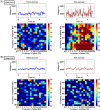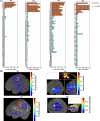Seizure onset zone identification using phase-amplitude coupling and multiple machine learning approaches for interictal electrocorticogram
- PMID: 37969944
- PMCID: PMC10640557
- DOI: 10.1007/s11571-022-09915-x
Seizure onset zone identification using phase-amplitude coupling and multiple machine learning approaches for interictal electrocorticogram
Abstract
Automatic seizure onset zone (SOZ) localization using interictal electrocorticogram (ECoG) improves the diagnosis and treatment of patients with medically refractory epilepsy. This study aimed to investigate the characteristics of phase-amplitude coupling (PAC) extracted from interictal ECoG and the feasibility of PAC serving as a promising biomarker for SOZ identification. We employed the mean vector length modulation index approach on the 20-s ECoG window to calculate PAC features between low-frequency rhythms (0.5-24 Hz) and high frequency oscillations (HFOs) (80-560 Hz). We used statistical measures to test the significant difference in PAC between the SOZ and non-seizure onset zone (NSOZ). To overcome the drawback of handcraft feature engineering, we established novel machine learning models to learn automatically the characteristics of the obtained PAC features and classify them to identify the SOZ. Besides, to handle imbalanced dataset classification, we introduced novel feature-wise/class-wise re-weighting strategies in conjunction with classifiers. In addition, we proposed a time-series nest cross-validation to provide more accurate and unbiased evaluations for this model. Seven patients with focal cortical dysplasia were included in this study. The experiment results not only showed that a significant coupling at band pairs of slow waves and HFOs exists in the SOZ when compared with the NSOZ, but also indicated the effectiveness of the PAC features and the proposed models in achieving better classification performance .
Keywords: Electrocorticogram (ECoG); Focal cortical dysplasia (FCD); Interictal; Machine learning; Phase-amplitude coupling (PAC).
© The Author(s) 2022.
Figures







Similar articles
-
Seizure Onset Zone Identification Based on Phase-Amplitude Coupling of Interictal Electrocorticogram.Annu Int Conf IEEE Eng Med Biol Soc. 2021 Nov;2021:587-590. doi: 10.1109/EMBC46164.2021.9630941. Annu Int Conf IEEE Eng Med Biol Soc. 2021. PMID: 34891362
-
Interictal coupling of HFOs and slow oscillations predicts the seizure-onset pattern in mesiotemporal lobe epilepsy.Epilepsia. 2019 Jun;60(6):1160-1170. doi: 10.1111/epi.15541. Epub 2019 May 14. Epilepsia. 2019. PMID: 31087662
-
High-frequency Oscillations and the Seizure Onset Zones in Neocortical Epilepsy.Chin Med J (Engl). 2015 Jul 5;128(13):1724-7. doi: 10.4103/0366-6999.159342. Chin Med J (Engl). 2015. PMID: 26112710 Free PMC article.
-
How to establish causality in epilepsy surgery.Brain Dev. 2013 Sep;35(8):706-20. doi: 10.1016/j.braindev.2013.04.004. Epub 2013 May 15. Brain Dev. 2013. PMID: 23684007 Free PMC article. Review.
-
Interictal oscillations and focal epileptic disorders.Eur J Neurosci. 2018 Oct;48(8):2915-2927. doi: 10.1111/ejn.13628. Epub 2017 Jul 18. Eur J Neurosci. 2018. PMID: 28644911 Review.
Cited by
-
Predicting seizure onset zones from interictal intracranial EEG using functional connectivity and machine learning.Sci Rep. 2025 May 22;15(1):17801. doi: 10.1038/s41598-025-02679-4. Sci Rep. 2025. PMID: 40404720 Free PMC article.
-
Machine learning detection of epileptic seizure onset zone from iEEG.Biomed Eng Lett. 2025 May 27;15(4):677-692. doi: 10.1007/s13534-025-00480-w. eCollection 2025 Jul. Biomed Eng Lett. 2025. PMID: 40621609 Free PMC article. Review.
-
Dynamic evolution of frontal-temporal network connectivity in temporal lobe epilepsy: A magnetoencephalography study.Hum Brain Mapp. 2024 Oct;45(14):e70033. doi: 10.1002/hbm.70033. Hum Brain Mapp. 2024. PMID: 39319686 Free PMC article.
References
-
- Akter MS, Islam MR, Iimura Y, Sugano H, Fukumori K, Wang D, Tanaka T, Cichocki A. Multiband entropy-based feature-extraction method for automatic identification of epileptic focus based on high-frequency components in interictal ieeg. Sci Rep. 2020;10:7044. doi: 10.1038/s41598-020-62967-z. - DOI - PMC - PubMed
-
- Akter MS, Islam MR, Tanaka T, Iimura Y, Mitsuhashi T, Sugano H, Wang D, Molla MKI. Statistical features in high-frequency bands of interictal ieeg work efficiently in identifying the seizure onset zone in patients with focal epilepsy. Entropy (Basel) 2020;22(12):1415. doi: 10.3390/e22121415. - DOI - PMC - PubMed
LinkOut - more resources
Full Text Sources

